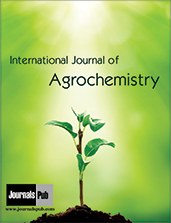Editor Overview
IJA maintains an Editorial Board of practicing researchers from around the world, to ensure manuscripts are handled by editors who are experts in the field of study.
Publisher
JournalsPubAn Imprint of Dhruv Infosystems Pvt Ltd
A-118, 1st Floor, Sector-63, Noida, U.P. India,Pin-201301
E-mail: [email protected]
(Tel):
(Mob) (+91) 9810078958, +919667725932
Focus and Scope

About the Journal
International Journal of Agrochemistry aims to serve as a platform for the propagation of novel ideas and research in entire areas of Agricultural Chemistry. The target audience of the journal comprises both researchers and practitioners. All manuscripts go through a rigorous peer review process. It is designed to create interest among researchers in the field of Agricultural, chemical process engineering and the technologies applied in chemical composition of biochemical constituents, pesticides, fertilizers, agro-products etc. Journal targets to publish original, high quality papers that are peer-reviewed by our expert editorial team to ensure the publication of only good quality papers.
All contributions to the journal are rigorously refereed and are selected on the basis of quality and originality of the work. The journal publishes the most significant new research papers or any other original contribution in the form of reviews and reports on new concepts in all areas pertaining to its scope and research being done in the world, thus ensuring its scientific priority and significance.
Focus and Scope
-
Chemical/biochemical composition of components: Arbutus unedo; biochemical assessment; antioxidant capacity; phenolic compounds; Morocco, Triticum aestivum; carbon dioxide; minerals; protein; starch; baking properties; crop quality; food security, Trachymene incisa; Apiaceae; Chemotype; -Selinene; Bicyclogermacrene; -Bisabolene; -Pinene; -Caryophyllene; Essential oil; Chemical composition, plant defense; herbivory; mechanical wounding; oral secretions; induced volatiles; SpitWorm; MecWorm; Phaseolus lunatus; Spodoptera littoralis; volatile organic compounds, Rattlesnake; Crotalus; Sistrurus; Venom; Toxin; Association, steppe; habitat fragmentation; carabid beetles; community; richness; abundance.
-
Chemistry, composition, and processing of agricultural pesticides and insecticides: Bioeconomy, bibliographic databases, value chains agricultural, production, coordinated development degree; agricultural water resources; socio-economy development; Shanxi Province, agricultural eco-efficiency; DEA-SBM model; Spatio-temporal evolution pattern; improvement potential; Jiangsu Province, agricultural productivity; agrometeorology; climate change; crop yield, AO; SAO; TO; amplitude; phase, biomineralization; calcium ions; magnesium ions; Bacillus lichemiformis; carbonates, millimeter-wavelength cloud radar; attenuation correction; dual-radar; data fusion, life quality, risk assessment, soil risk, key questions, answer, remediation, waste, soil contamination.
-
Veterinary drugs: broiler; feed additives; LC-MS/MS; meat legislation; meat safety; poultry meat; veterinary drugs, Antimicrobial stewardship; veterinary; complex intervention, cannabis; cannabinergic; drug; FDA-approved; medical conditions; pharmaceutical-grade; phytocannabinoid, MEDICINE & PHARMACOLOGY, Pharmacology & Toxicology, shelter medicine; animal sheltering; shelter surgery; veterinary medical education; veterinary student training; population medicine; biosecurity, academic performance; COVID-19; veterinary; online learning, efficacy; ethnoveterinary; livestock; medicine; smallholder farmer, cheminformatics; docking simulation; drug repositioning; thiopurine; tyrosinase, antimicrobial resistance; antimicrobial stewardship; barriers; perception; survey; veterinary practitioners, BRF2; cancer; molecular dynamics simulation; drug repurposing; drug discovery, NS; Drug receptors; GABA; Cannabinoid; Opioid; Serotonin; Dopamine.
-
Plant growth promoting regulators: biofertilizers; sustainable agriculture; plant growth-promoting rhizobacteria; microbial formulations, pear trees; TIMAC AGRO Italia; growth regulator; sustainable development; plant nutrition, Phytoremediation; Petroleum hydrocarbon-degrading bacteria; Salix; Eleocharis; Alkanes; Polycyclic aromatic hydrocarbons; Plant growth promoting rhizobacteria,PGPR; salt stress; salinity; abiotic stress; ACC deaminase; seed priming; IAA, Trichoderma atroviride; volatile organic compounds; tomato; biostimulation; biocontrol; Fusarium wilt disease, Cicer arietimum; Indole Acetic Acid; Bacillus megaterium; Pseudomonas putida; Mesorhizobium ciceri,Bio-inoculants; Consortium; Treatment; PGPB,ethics; regulator; superintelligence; super-ethical systems; requisite variety; cybernetics; third-order cybernetics; cyberanthropic utopia; grand challenge, abiotic stresses; gene-expression; genomics; ion homeostasis; plant growth and development; plasma membrane; sugar translocation.
-
Fertilizers and other agro-chemicals, including their metabolism, toxicology, and environmental issues: Biohydrogen; photo-fermentation; agro-waste, rainwater; weather; windbreaker; cup anemometer; dry and wet bulb thermometers, bioenergy; Camelina sativa; energy crops; agro-climatic suitability; biodiesel, Agro-economic crop water productivity; Hydro-economic modeling; CSPSO-MODSIM; Economic benefits; Crop pattern planning; Crop water Irrigation depth; Climate change; Iran, biomineralization; halophilic bacteria; precipitation; carbonate minerals; Mg/Ca ratios; nucleation sites, Land use change; urban sprawl; Logistic regression; Markov chain; Cellular automata; Gilan Province, conservation; governance; habitat loss; livelihood; eco-tourism; carbon credits, heavy metal; contamination assessment; X-ray fluorescence; bus station dusts, maximum surface air temperature; land surface temperature; statistical modeling; MODIS.
-
Processing effects on the composition and safety of agricultural products: Forest ecosystem; Fluxnet; Soil respiration; Net ecosystem Exchange; Phenology, satellite; rainfall; estimates; rain gauge; uncertainties; topography; seasonality; Food, security, safety, fiber, invasive, pests, Bio-Terrorism, Inspection Services, farmers, social trust, cleaner production, production behaviors, rural, Technology, Cropland, Cadmium, remediation, Maize, risk.
Open Access Statement
IJA is an open-access (OA) publication which provides immediate open access to its content on the principle that making research freely available to the public supports a greater global exchange of knowledge. All published works will be available to a worldwide audience, free, immediately upon publication. Publication in the journal is subject to payment of an article processing charge (APC). The APC serves to support the journal and ensures that articles are freely accessible online in perpetuity under a Creative Commons licenses.
Publication Ethics Statement
IJA fully adhere to Code of Conduct of Publication Ethics (COPE) and to its Best Practice Guidelines. The Editorial Team enforces a rigorous peer-review process with strict ethical policies and standards to ensure the addition of high-quality scientific studies to the field of scholarly publication. In cases where ctit becomes aware of ethical issues, it is committed to investigating and taking necessary actions to maintain the integrity of the literature and ensure the safety of research participants. Click here to read more about the Research & Publication virtue ethics
Content Disclaimer
All IJA the information’s, opinions, and views mentioned here represents the authors and the contributions of the articles. Publication of articles, advertisements, or product information does not constitute endorsement or approval by the journal. cannot be help responsible for any error or consequences while using the information updated in this journal. Although every effort is done by ctit to see that there’s no any inaccurate data, misleading data, opinion or statement within the journal, the data and opinions appearing in the articles are the responsibility of the contributors concerned.



